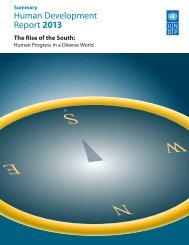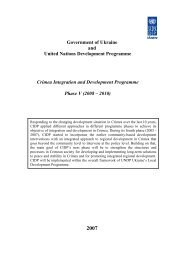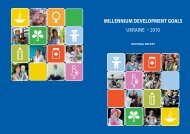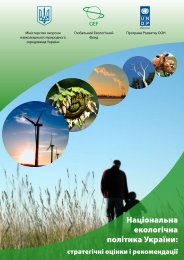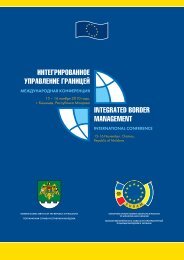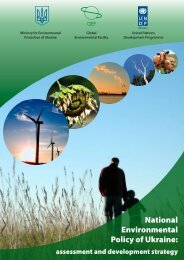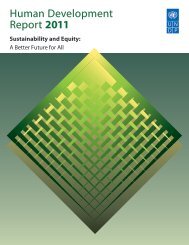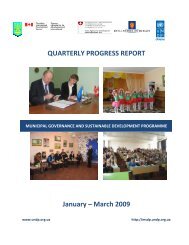E N S W - United Nations Development Programme
E N S W - United Nations Development Programme
E N S W - United Nations Development Programme
You also want an ePaper? Increase the reach of your titles
YUMPU automatically turns print PDFs into web optimized ePapers that Google loves.
While environmental threats such as climate<br />
change, deforestation, air and water pollution,<br />
and natural disasters affect everyone, they hurt<br />
poor countries and poor communities most.<br />
Climate change is already exacerbating chronic<br />
environmental threats, and ecosystem losses<br />
are constraining livelihood opportunities,<br />
especially for poor people. A clean and safe<br />
environment should be seen as a right, not<br />
a privilege. The 2011 Human <strong>Development</strong><br />
Report highlighted that equity and sustainability<br />
are inextricably linked. Sustainable societies<br />
need policies and structural changes that align<br />
human development and climate change goals<br />
through low-emission, climate-resilient strategies<br />
and innovative public-private financing<br />
mechanisms. 30<br />
Most disadvantaged people contribute little<br />
to global environmental deterioration, but<br />
they often bear the brunt of its impacts. 31 For<br />
example, although low HDI countries contribute<br />
the least to global climate change, they are<br />
likely to experience the greatest loss in annual<br />
rainfall and the sharpest increases in its variability,<br />
with dire implications for agricultural<br />
production and livelihoods. The magnitude of<br />
such losses highlights the urgency of adopting<br />
coping measures to increase people’s resilience<br />
to global climate change. 32<br />
Natural disasters, which are increasing in<br />
frequency and intensity, cause enormous economic<br />
damage and loss of human capabilities.<br />
In 2011 alone, natural disasters accompanying<br />
earthquakes (tsunamis, landslides and ground<br />
settlements) resulted in more than 20,000<br />
deaths and damages totalling $365 billion,<br />
including loss of homes for about a million<br />
people. 33 The impact has been severe for small<br />
island developing states, some of which have<br />
incurred losses of 1% of GDP—and some as<br />
much as 8% or even multiples of their GDP.<br />
St. Lucia, for example, lost almost four times<br />
its GDP in 1988 from Hurricane Gilbert,<br />
and Granada lost twice its GDP in 2004 from<br />
Hurricane Ivan. 34<br />
The 2011 Human <strong>Development</strong> Report examined<br />
several environmental scenarios. The<br />
“environmental challenge” scenario factored<br />
in the anticipated adverse effects of global<br />
warming on agricultural production, access to<br />
clean water and improved sanitation, and pollution.<br />
Under this scenario, the average global<br />
HDI value would be 8% lower by 2050 than<br />
under the “base case” scenario, which assumes<br />
a continuation but not a worsening of current<br />
environmental trends. Most dramatically, the<br />
average regional HDI value in both South Asia<br />
and Sub-Saharan Africa would be 12% lower<br />
under the environmental challenge scenario<br />
than under the base case scenario. Under a<br />
more severe “environmental disaster” scenario,<br />
the global HDI value in 2050 would fall 15%<br />
below that under the baseline scenario—22%<br />
below in South Asia and 24% below in Sub-<br />
Saharan Africa, effectively halting or even<br />
reversing decades of human development progress<br />
in both regions.<br />
This Report looks more specifically at the<br />
impact of these environmental scenarios on<br />
the number of people living in extreme income<br />
poverty (figure 4.4). Some 3.1 billion more<br />
people would live in extreme income poverty in<br />
2050 under the environmental disaster scenario<br />
than under the accelerated progress scenario<br />
(table 4.3). Under the base case scenario, by<br />
contrast, the number of people in extreme<br />
income poverty worldwide would decline<br />
by 2050.<br />
Some 2.7 billion more people would live in<br />
extreme income poverty under the environmental<br />
disaster scenario than under the base<br />
case scenario, a consequence of two interrelated<br />
factors. First, the model shows an increase of<br />
1.9 billion people in extreme income poverty<br />
due to environmental degradation. Second,<br />
environmental calamities would keep some<br />
800 million poor people from rising out of extreme<br />
income poverty, as they would otherwise<br />
have done under the base case scenario (see<br />
Technical appendix).<br />
These outcomes underscore a central message<br />
of this Report: environmental threats are<br />
among the most grave impediments to lifting<br />
human development, and their consequences<br />
for poverty are likely to be high. The longer<br />
action is delayed, the higher the cost will be.<br />
Managing demographic change<br />
Between 1970 and 2011, the world population<br />
swelled from 3.6 billion to 7 billion.<br />
<strong>Development</strong> prospects are influenced by the<br />
age structure of the population, as well as its<br />
size. 35 Declining fertility rates and shifts in<br />
Some 3.1 billion more<br />
people would live<br />
in extreme income<br />
poverty in 2050 under<br />
an environmental<br />
disaster scenario than<br />
under the accelerated<br />
progress scenario<br />
Chapter 4 Sustaining momentum | 95



